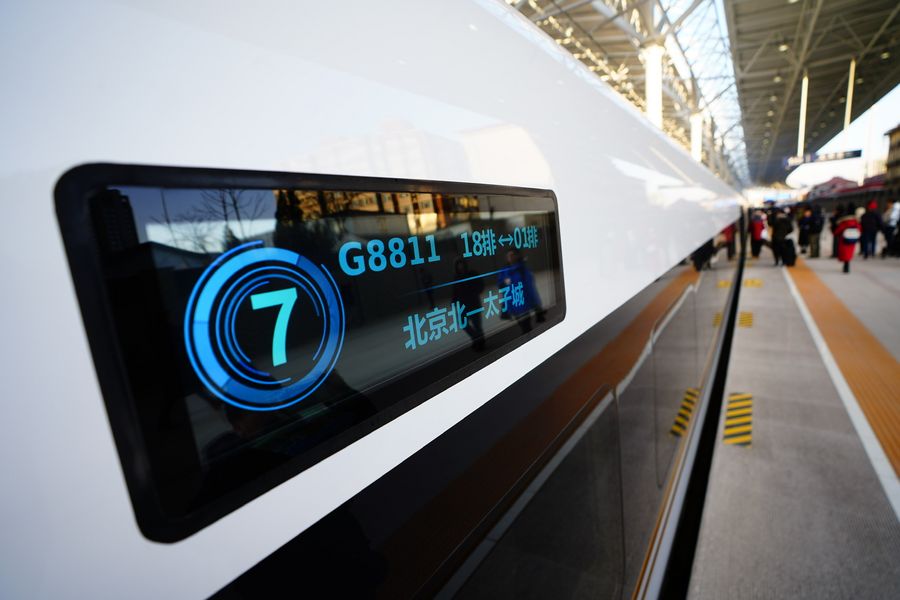Some 110 years after China's first independently designed and built railway went operational between Beijing and Zhangjiakou, the new high-speed railway line connecting the two cities was launched Monday, facilitating inter-city traffic and crucial for the co-host of the 2022 Beijing Winter Olympics.
BEIJING, Dec. 30 (Xinhua) -- The high-speed railway line connecting Beijing and Zhangjiakou, the co-host city of the Beijing 2022 Winter Olympics, went into operation Monday, the China State Railway Group Co., Ltd. said.
With 5G signals, wireless charging and intelligent lighting, the smart train G8811 departed from Beijing North Railway Station at around 8:30 a.m. to Zhangjiakou in north China's Hebei Province.
The railway is 174 km long, with 10 stations along the line. Several underground tunnels were built on the route so trains can avoid traversing through scenic spots.

People wait to get on the G8811 high-speed train bound for Taizicheng Railway Station at Beijing North Railway Station in Beijing, capital of China, Dec. 30, 2019. (Xinhua/Xing Guangli)
With a maximum design speed of 350 kph, it will reduce the travel time between Beijing and Zhangjiakou from over three hours to 47 minutes, facilitating inter-city traffic and crucial for the co-host of the 2022 Beijing Winter Olympics.
Chongli railway, a branch line of the Beijing-Zhangjiakou high-speed railway, also went into service Monday. It is 53 km long, with a maximum design speed of 250 kph.
Yang Yang, a Winter Olympic champion and chairwoman of the Athletes' Commission of Beijing 2022 Winter Olympics, was among passengers on the high-speed train G8811.

China's Winter Olympics gold medalist Yang Yang (Front) takes the G8811 high-speed train bound for Taizicheng Railway Station at Beijing North Railway Station in Beijing, capital of China, Dec. 30, 2019. (Xinhua/Peng Ziyang)
Yang said Beijing-Zhangjiakou high-speed railway is important to the preparation of the 2022 Olympic and Paralympic Winter Games. "It can improve the efficiency of our work, promote China's winter sports, and boost the ice and snow economy."
Construction of the high-speed railway lasted around four years. The railway underwent test runs earlier this month.
"The Beijing-Zhangjiakou high-speed railway is a milestone in China's railway development," said Wang Hongyu, chief designer in charge of this railway project with Railway Engineering Consulting Group Co., Ltd.
He said the railway construction has adopted China's latest achievements in railway development from equipment manufacturing, new materials to new artificial intelligence technology.
The trains on the Beijing-Zhangjiakou high-speed rail line can automatically start and stop, run between stations, open and close doors, as well as handle emergencies. It is the first time for China to have an autonomous high-speed train.
For the athletes, an area for snowboards and other ski equipment is also available on the train. E-ticket services have been launched to enable passengers to use their ID cards or scan QR codes for authentication instead of waiting in line for paper stubs.

Passengers pose for photos on the G8811 high-speed train bound for Taizicheng Railway Station running on the newly opened Beijing-Zhangjiakou high-speed railway, Dec. 30, 2019. (Xinhua/Peng Ziyang)
Designed by Zhan Tianyou, known as the "father of China's railroad," the original railway linking Beijing and Zhangjiakou was put into operation in 1909. It was known as China's first independently designed and built railway.
The construction was considered impossible at the time without foreign assistance. Zhan, together with his colleagues, however, strived to complete its construction two years ahead of schedule, inventing a zigzag railway design using two locomotives instead of one to power trains on a steep mountain slope.
From 35 to 350 kph, the 110-year-old Beijing-Zhangjiakou railway is a witness of "China speed."
The length of China's railroad lines in service has exceeded 139,000 km, including 35,000 km of high-speed rail, ranking first in the world.
"It only takes 47 minutes of the train trip from sports venues in Beijing to those in Zhangjiakou, providing safe and convenient transportation for athletes and spectators," said Li Yan, chairwoman of the China Skating Association.
High-speed trains are not just a means of transport but also a key driver of economic development.

Photo taken on Dec. 30, 2019 shows the G8811 high-speed train bound for Taizicheng Railway Station at Beijing North Railway Station in Beijing, capital of China, Dec. 30, 2019. (Xinhua/Xing Guangli)
The completion of the Beijing-Zhangjiakou line is expected to facilitate the integrated development of Beijing, Tianjin and Hebei, a regional city cluster called "Jing-jin-ji."
It also connects with other high-speed routes across north China's Shanxi and Hebei provinces and Inner Mongolia Autonomous Region.
Zhan Xin, the great-granddaughter of Zhan Tianyou, was among the first batch of passengers who took the Beijing-Zhangjiakou high-speed train Monday morning.
"The fast trains reflect China's economic and technological development. If my great-grandfather could have seen today's high-speed rail network, he would be very proud," she said.
(Reporting by Cheng Lu, Ding Jing, Luo Xin, Fang Ning, Li Dexin, Ji Xiaobo)
(Video reporters: Qu Lanjuan, Fan Xi, Meng Jing, Zhao Xu; Video editor: Luo Hui)■



